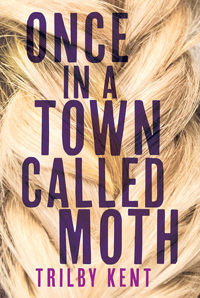| ________________
CM . . .
. Volume XXIII Number 5. . . .October 7, 2016

 |
Once in a Town Called Moth.
Trilby Kent.
Toronto, ON: Tundra Books, 2016.
220 pp., hardcover & ebook, $21,99 (hc.).
ISBN 978-1-101-91811-1 (hc.), ISBN 978-1-101-91813-5 (ebook).
Grades 8-10 / Ages 13-15.
Review by Charlotte Duggan.
*** /4
|
| |
|

excerpt:
“Wow. You’re gorgeous, do you know that? Like how I imagined, only...” She shook her head, wiped her eyes. “Taller. So tall, like your father. Like a goddess. My beautiful daughter...”
The middle part of her mother’s face was familiar, but the flesh around it had filled out, obscuring those bits Ana should have recognized. An attractive face, not as young as she’d expected. More surprising was the way she wore her hair like a mane down her back, dangly gold earrings with little colored glass beads, a scarf unwound to reveal layered V-necks. There was nothing of Colony Felicidad here, no trace of those people, that life.
They sat, facing one another.
The fish out of water theme provides an ideal scaffold from which to explore the confusion of adolescence because, of course, every teen feels like a fish out of water. In Trilby Kent’s novel Once in a Town Called Moth the fish is 14-year-old Anneli, and the new world she finds herself in is Toronto, Canada.
Ana, as she is now called, and her father are on the run from their old colony Mennonite community in Bolivia. But Ana is not certain who or what they are running from. Her uncertainty infuses the story with mystery. Very quickly the mystery is compounded by Ana’s awareness that her mother, who fled their Bolivian community 10 years ago, may also be living in Toronto.
While her father finds work, Ana sets up house, and both attempt to adapt to their strange new lives and both, independently of each other, try to find Ana’s mother. Everything is strange, especially the food. Ana tells how one night her father brought home a “cardboard box with hot grease stains seeping through the bottom and we ate the circle of soggy bread covered in melted cheese and a red paste.” Manitoba readers in particular will, thanks to a large Mennonite population and familiarity with Mennonite cuisine, appreciate the cameo role Kent gives to food and cooking.
And then, like a warm tidal pull, Ana’s 14-year old neighbour Suvi knocks at the door. Suvi is also an outsider, although perhaps more by choice than circumstance. She serves to guide Ana through the treacherous waters of Canadian teen culture. She is wonderfully insightful and a very creative thinker. Suvi also helps Ana find her mother by teaching her how to use the Internet. She tells Ana: “First, you have to find a chat room. Like if you were looking for a Star Wars geek, maybe you’d try a sci-fi chat room.”
Rounding out the complement of outsiders is Suvi’s gay friend Mischa who doesn’t “know how to wound and is wounded so easily.” The three spend the rest of the summer bonding and prepping for grade 9. Kent’s take on high school, replete with bullies, mean girls and a disillusioned but helpful French teacher, will be familiar tropes to most readers. Ana’s exotic foreignness provides her with just enough of a shield to allow her into this heavily nuanced culture without becoming its target, mostly.
The momentum and tension in this story are maintained by Ana’s search for her mother. But what is really surprising is that, even after Ana and her mother are reunited, the suspense continues to grow. Neither of Ana’s parents is willing to reveal the details of the incident that drove Ana’s mother from the colony in Bolivia, and so. as readers, we hold on until all is disclosed and resolved, just like Ana.
The truth of this story can be found in the relationships Kent creates and builds. Kent has a knack for seeing and articulating that spacy world where disconnected teens often find connections. From Suvi’s impulsive, quirky love for Ana, as seen here near the end of the novel:
“You’re crazy,” said Ana.
“There are drugs that can take care of that.” Suvi jabbed her in the ribs. On the other hand, you’ll always be a Menno.
...to the availability the French teacher’s recent divorce opens up for a relationship with a young Menno girl, there is a deep undercurrent of authenticity to this story. Ana’s respect and love for her father and the gut wrenching doubt and love she feels for her mother are palpable. Yet both relationships are complicated by secrets and silence.
It’s all very intriguing, but whether it’s intriguing enough for its intended junior high audience is another matter. Once in a Town Called Moth requires a level of maturity and patience, particularly during the first third as the groundwork for the story is being laid. And while the characters are interesting and likeable, they may lack in originality.
Recommended.
Charlotte Duggan is a teacher-librarian in Winnipeg, MB.

To comment
on this title or this review, send mail to cm@umanitoba.ca.
Copyright © the Manitoba Library Association. Reproduction for personal
use is permitted only if this copyright notice is maintained. Any
other reproduction is prohibited without permission.
Next Review | Table of Contents For This Issue - October 7, 2016
CM Home | Back Issues
| Search
| CM Archive
| Profiles Archive
|
